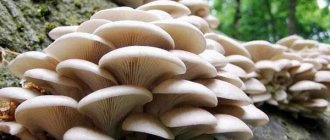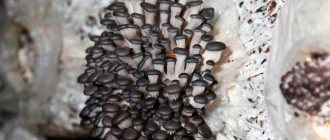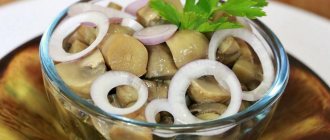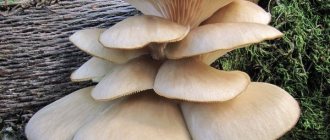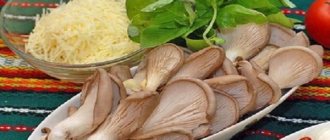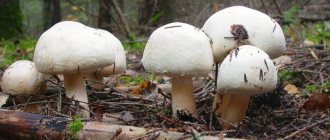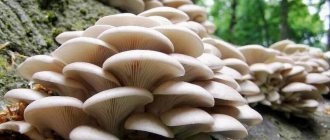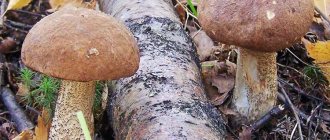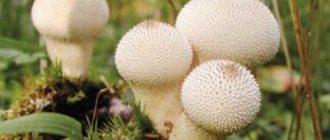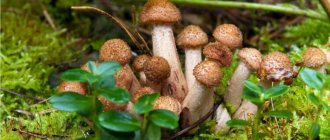Oyster mushroom (or oyster mushroom) is a surprisingly tasty and nutritious representative of the oyster mushroom family, noticeably different from most of its forest relatives.
After all, it does not grow on the ground among pine needles or fallen leaves, but directly on the trunk of a tree. In terms of its chemical composition, oyster mushroom is close to meat and dairy products. The beneficial properties of this representative of the mushroom kingdom are also beyond doubt. Along with its low calorie content, its fruiting body contains a lot of protein, vitamins B, C, E, D, PP, as well as a variety of minerals and amino acids necessary for humans. Such a rich composition has a beneficial effect on our health, saturating the body with valuable substances without harming the figure, lowering cholesterol levels, strengthening the immune system, normalizing blood pressure and cleansing the body of toxins.
Despite the many positive properties of oyster mushrooms, it is not recommended for children under 5 years of age.
So where and when can you collect a basket of such a tasty and healthy product? Or can you grow oyster mushrooms yourself?
Description and appearance
Oyster mushroom is a conditionally edible mushroom that rarely grows alone, more often in groups. Its features:
- Hat. Diameter from five to fifteen centimeters. It has a fleshy, solid structure. Most often it has a round shape with a thin edge, but it can also be ear-shaped. In young fruits it is more convex, in old ones it is flat.
- Pulp. It has a white tint and is dense. As the mushroom ages, it changes from very soft and juicy to hard and fibrous. It has a pleasant taste.
- Leg. Short and slightly curved. Its length is from two to five centimeters, and its thickness is from 0.8 to 3 cm. The shape resembles a cylinder, narrowed at the base. Features a smooth white surface.
Description of the mushroom
Oyster mushroom belongs to the oyster mushroom family. Most types of this mushroom are completely edible, so it is used in cooking in all countries of the world.
Oyster mushroom can be recognized by the following distinctive features:
- The hat can be colored brown-gray, bluish-gray and creamy-brown. Moreover, the color saturation closer to the center of the cap will be higher than at its edge. In addition, the color of the mushroom cap may change over time.
- The leg of the oyster mushroom is most often asymmetrical. It is rarely located in the center of the cap. The maximum height of the stem is 5 cm and the width is 2 cm. In ripe mushrooms, the stem becomes rigid.
- Oyster mushrooms always grow in groups. Moreover, the fruiting bodies of individual mushrooms often grow together.
- The flesh of the mushroom is dense. In young oyster mushrooms it is juicy and tender. Old mushrooms have coarse and tough flesh with distinct fibers.
- The plates on the bottom of the cap are white. They smoothly descend to the leg, where they are connected to it by means of jumpers.
Oyster mushroom reproduces by spores. They can be seen with the naked eye. They are ovoid in shape and colored light gray with a purple tint.
When and where do oyster mushrooms begin to grow in nature?
The season begins in September and lasts from November to December. Mushrooms reach their peak growth in September-October. Oyster mushrooms easily tolerate sub-zero temperatures, and if the climate allows, they also appear in May-June.
You can find mushrooms in temperate forests on stumps or deciduous trees. Among the latter, it may be oak, birch, rowan or aspen. In rare cases, mushrooms may choose a coniferous tree as a habitat. They can be found on trunks high above the ground - up to thirty fruiting bodies at once.
Growing season
The period for full ripening of oyster mushrooms from the formation of small rudiments to the moment of harvesting the fruiting bodies is 6-8 days. During this period, small tubercles grow into a sprawling, adult mushroom.
Since culture develops in families, similar to fusions, both large and very small representatives can “climb out” from one base. Here it is very important to know the main rule for collecting oyster mushrooms - you need to cut off the entire block at once. Inexperienced collectors leave the plants to “ripen”, after which they encounter trouble - after a few days of waiting, the babies become a little larger, but the adult mushrooms dry out or become moldy, thereby making the entire growth unsuitable for food. If you cut off large bodies, leaving small ones, they will still not grow, since the integrity of the plant is compromised.
As for the fruiting season, the first mushrooms can be found from the beginning of August, the main waves of ripening occur in September - November. As you can already understand, the crop ripens in several passes, while the mycelium slowly becomes obsolete: the first wave “sells” about 70 percent of the fruits, the second – about 25. The third wave accounts for no more than 10 percent of the harvest. The period of a complete technological cycle of a plant is 60–75 days, breaks between waves are 10–14 days. Experienced mushroom pickers prefer to visit the forest before the end of the second wave, since trips to the “third circle” take a lot of effort, but are practically not rewarded with prey.
Varieties of oyster mushroom
Oyster mushrooms have several varieties:
- Covered. The hat, three to five centimeters in diameter, has a brownish-gray tint. The growth of the fungus begins at the end of April and ends in July. Habitat: aspens. The variety is common in Central and Northern Europe. The mushroom is distinguished by the presence of very dense, “rubbery” pulp, therefore it is practically inedible.
- Oak. The white cap has a diameter of 4 to 10 cm. The edible mushroom can be found in deciduous forests. The pulp has a sweet or sour aroma.
- Horn-shaped. The concave-shaped hat has a wavy edge and a diameter of three to twelve centimeters. The white pulp has a floury smell and is extremely soft.
- Royal or steppe. There is a tubercle in the middle of the red-brown cap, but as the mushroom ages, the cap takes on a flatter and more compressed appearance. Its diameter is 4.5-13 cm. The pulp has no distinct odor.
- Pulmonary. The shape of the hat resembles a tongue. Its diameter varies from four to nine centimeters. The thin white pulp is elastic.
Oyster mushroom recipes
In Asian countries, this mushroom has long been used to prepare various dishes. Since it began to be cultivated in Europe, it has been considered a delicacy. Fruit bodies are boiled, stewed, fried, pickled. For some recipes they are the main component, in others they complement the taste of the dish.
Salad
- 300 gr. Break the spring mushrooms with your hands and fry them in vegetable oil with one onion.
- Tear a bunch of arugula (do not cut it) and combine with the prepared mushrooms.
- Pour over the sauce.
Sauce: mix olive oil with lemon vinegar or lemon juice in a ratio of 3:1, add 1 tsp. fenugreek (dry aerial part), taste with salt and pepper. Optional - hard cheese, cut into thin slices.
Pie
- 250 gr. Boil the oyster mushrooms.
- Sauté 2 onions in olive or sunflower oil.
- 100 gr. grate hard cheese.
Place a sheet of defrosted yeast puff pastry on a baking sheet, distribute mushrooms and onions, sprinkle with cheese. Cook at 180 degrees.
The benefits and harms of mushrooms
Properly collected mushrooms will delight you not only with their taste, but also with their beneficial qualities:
- rich in vitamins;
- contains easily digestible carbohydrates;
- the pulp is rich in substances that kill germs and parasites.
Since the mushroom contains a lot of fiber, oyster mushroom is considered a low-calorie product. Therefore, if you are on a diet, then you can safely eat it - 100 grams contain only 33 kcal.
However, when consuming such mushrooms, it is worth remembering their conditional edibility. They can cause harm:
- The pulp contains chitin - this substance is not absorbed by the child’s body, so it is better not to give it to children under five years of age. And then give in small quantities;
- if you have diseases of the liver, gastrointestinal tract, pancreas or kidneys, it is better to avoid mushrooms;
- If you are prone to allergic reactions, you need to collect and process mushrooms with extreme caution.
If mushrooms are eaten no more than twice a week, they will not cause harm.
Growing at home
At home, oyster mushrooms are grown on a specially prepared substrate. Straw often plays its role. The main thing is that it is clean, not infected and free of unpleasant odor.
Before using straw as a substrate, it is best to subject it to hydrothermal treatment. To do this, it should be placed in a large container and compacted thoroughly. After this, you need to fill the container with warm water and additionally heat it over low heat to 70 ° C. At this temperature, the straw should be kept for at least 3 hours.
After draining the water, the substrate must be removed from the container and cooled. While the straw is cooling, you can prepare the planting containers and mycelium. Plastic bags are most often used as containers.
When planting, a layer of substrate is first laid out, and then a layer of mycelium is laid down. Then the procedure is repeated until the landing container is completely filled. In this case, care should be taken to ensure that the total proportion of mycelium in the container does not exceed 5%.
When breeding oyster mushrooms at home, you should remember the following rules:
- When planting, the mycelium must be distributed so that most of it is located closer to the walls of the planting container.
- The filled unit must be placed in dark rooms with a temperature not lower than 20 and not higher than 24 °C. Otherwise, the mycelium will die.
- The block should be sprayed with water from time to time.
If everything was done correctly, the first primordia will appear in about 3 weeks. These buds do not need to be watered. You just need to monitor the temperature in the room.
On the 3rd day after the appearance of primordia, they turn into adult mushrooms. However, they can only be collected after the edges of the caps are aligned. When picking, mushrooms need to be twisted out of the substrate or cut off at the very base. The next harvest can be harvested in 2 weeks.
Is it possible to grow this type of mushroom yourself?
It is not difficult to grow oyster mushrooms yourself at home. The process does not require serious financial investments, but you will get a large harvest - 1 kg of mycelium produces 4 kg of mushrooms. Open ground or indoors are suitable for cultivation. Mycelium is sold in specialized stores. High-quality mycelium is usually white or orange with red splashes. After purchasing, it is better to keep it in a cool place for 14 days to a month.
How long do mushrooms grow after rain? Diary of a mushroom picker. Mushroom growth rate.
They grow like mushrooms after rain...
But really, how fast do mushrooms grow?
Record holder for speed of growth of Veselka -
Boletuses, boletuses and white boletuses do not grow so quickly, but already on the 2-3rd day they are of interest to the mushroom picker.
Day 1. Photo by Olga Gubanova
Day 2 photo by Olga Gubanova
Day 4 Photo by Olga Gubanova
In general, the fruiting body of a sponge mushroom grows in 5 days, then ripening and release of spores begins, but this process only frustrates mushroom pickers.
If a ripe white one can still be considered a trophy (many even prefer them to young ones for their richer taste), then boletus mushrooms older than 2 days are usually no longer of interest to the mushroom picker.
Lamellar mushrooms grow slower than tubular mushrooms, especially chanterelles. Chanterelles generally “freeze” under unfavorable conditions, such as drought, then begin to grow again. Many mushroom pickers noticed that the embryos of chanterelles (primordia) disappeared altogether, never starting to grow, as would be drawn back into the mycelium.
Of the lamellar ones, the fastest one is russula, which rises quite quickly from the litter above the ground and opens within 2-3 days.
Valui is also a russula. photo Flint
a day later - they opened up noticeably. photo Flint
Polypores grow slowly, especially on living trees. In general, the growth process depends on many factors - temperature, humidity, the strength of the mycelium itself, etc.
The main thing is that they grow! And we will find them in any case!
A piece
Well done to those who finished reading!
Subscribe if you love forests and mushrooms!
What methods can you use to grow mushrooms?
There are two ways to grow oyster mushrooms.
We talked in more detail about growing oyster mushrooms at home here.
Intensive
The intensive method is artificial, since cultivation is carried out in bags. If you choose this method, always keep the instruments and room sterile. It is necessary to work with gloves: when the mycelium warms to room temperature, grind it - 1 kg of 10 kg of soil. The latter can be made of straw or tree leaves. Make sure there are no signs of mold or rot. It is also necessary that the soil undergoes heat treatment and is moist during planting of the mycelium.
There are two ways to place soil with mycelium in a bag - mix the components or lay them in layers. After this, make small cuts in the bags and arrange them so that air gets in. You can harvest your first harvest in about 1.5 months.
Extensive
With the extensive method, the growing process will take place in a natural environment. For example, you can graft mycelium onto various trees - aspen, linden, poplar. To do this, wet the log with water and make a couple of deep cuts. Place the mycelium in the latter and cover with moss/tree bark. The place where you bury these logs should be in the shade. Be sure to water thoroughly. The first harvest can be harvested in 1.5-2 months.
Shelf life
Before preparing or selling, it is very important to check the crop for freshness and damage. It is also necessary to observe the technology and storage periods:
- At freezer temperature (-2-4 degrees) – 50-60 days;
- 0 + 6 degrees – 6-7 days;
- At room temperature – no more than 24 hours.
When technology is violated, mushrooms spoil and can become a source of food poisoning. To check the quality of a product, it is enough to examine it visually (for the presence of mold, rot, wateriness, worminess, mustiness).
We have reviewed information that answers the questions of when to collect oyster mushrooms, as well as exactly how to do it. Use the knowledge you have gained and your harvest will be rich and of high quality.
How to prepare the room
From the video on how to grow homemade oyster mushrooms, you can evaluate the entire cultivation process. However, it is important to properly prepare the basement before purchasing bags of spores.
The temperature in the room must be maintained in a stable condition. This is +20 degrees. Air humidity is permissible up to 90%. If there is not enough moisture, the basement needs to be regularly irrigated. If necessary, the room should be equipped with additional heaters.
What else should be in the basement with oyster mushrooms?
A ventilation system, absolute cleanliness and the absence of mold and pests are also the key to obtaining a good harvest of oyster mushrooms.
To do this, you should remove everything unnecessary from the basement, sweep it thoroughly and wash the floor. Next, prepare the bases on which the bags of substrate will hang.
If heat leaves the basement quickly, despite the fact that the room is optimally heated, it is important to seal the joints of the walls and windows. Ventilation should be carried out regularly, but it is important to avoid drafts.
What climate is necessary for active growth of the crop?
So, we have decided on the habitat of the family of mushrooms we are considering. However, this knowledge does not guarantee one hundred percent success in obtaining delicacies - it is necessary to take into account the growing season of the mushroom mycelium, the climate in which the rhizome begins its active growth.
It is impossible to determine the exact date of appearance of oyster mushroom fruiting bodies, since the temperature regime and the “bright” change of seasons are individual for each season. The approximate growing season of mushroom mycelium in the forests of our Motherland is from April to October for warm regions of the country, August - September for cold regions. If you are waiting for the right time to go harvest, do not rely on calendar dates; the best assistant is the presence of precipitation and the air temperature outside the window.
Oyster mushroom rhizome begins its active growth when:
- The air temperature fluctuates between 8-17 degrees plus.
- There was heavy rainfall, therefore the humidity increased.
If both conditions are met, you can go exploring.
Requirements for the premises and its preparation
Wood destroyers. This is the nickname given to oyster mushrooms. Growing conditions require a concrete or brick floor. The mushroom will eat away at the tree. In forests, oyster mushrooms are recyclers of dead trunks.
In an artificial environment, the “character” of the fungus does not change. Therefore, business flourishes in stone barns, basements, hangars, and industrial premises. They must be tall. A 3-meter ceiling is a minimum.
Such a room is needed for growing oyster mushrooms, since the substrate for the mushroom is usually placed in hanging bags. For a cost-effective business organization, it is worth placing them in 3 rows.
So the height of the ceiling is “eaten up”. If the area is rented, they usually pay per square footage. It is logical to take a room of a smaller area, but higher, than to distribute the same number of bags in breadth.
Some businessmen place the substrate for growing oyster mushrooms on the floor. In this case, it is easier to calculate the yield. About 50 kilograms of mushrooms are collected from one square. Accordingly, a harvest of 1,000 kilograms can be harvested at a time in a room of 100 square meters.
The technology for growing oyster mushrooms involves waterproofing the room. The mushroom loves moisture. Therefore, it is customary to cover walls and ceilings with polystyrene. The use of polyethylene film is also allowed. The main thing is that waterproofing is combined with ventilation. Fresh air is especially necessary during the growth period of the fungus. Air exchange should take place 4-5 times a day.
Equipment for growing oyster mushrooms may require heaters. Mushrooms are germinated at 20-22 degrees Celsius. Oyster mushrooms gain weight either at 20 or at 10-15 degrees. The latter case concerns winter strains of the crop, and the first – summer ones.
Caring for mushrooms indoors
The incubation period for mycelium germination is usually indicated on the packaging of the finished product and averages from 16 to 24 days. The room should be humid, warm and dark, and to maintain the required level of carbon dioxide, it should not be ventilated.
If the temperature rises too much, you can cool the bags a little with a fan, changing the direction of the air flow.
The time to move the bags into the room for mushroom growth is determined by the appearance of noticeable gray tubercles in the slots. This change in appearance indicates the formation of mycelium.
- In a greenhouse or other indoor space where bags with sprouted mycelium are transferred, the temperature should be maintained at 10-18 degrees and the humidity at least 90%.
- Additional lighting should be provided using lamps emitting cool-toned light for 8 hours daily. When mushrooms begin to grow, the room needs to be ventilated regularly.
The required humidity is achieved not by the usual watering of the soil substrate directly in bags, but by spraying water on the walls of the room. As the crop grows, it can be cut.
How many kg of oyster mushrooms per bag?
The yield of oyster mushrooms per block (bag) is approximately 3 kg from the first wave and 2 kg from the second, for a total of 5 kg from one bag.
Interesting materials:
What does WhatsApp stand for? What does the green color of the flag mean? What do impersonal verbs mean? What do 1st, 2nd and 3rd person verbs mean? What do perfective verbs mean? What do verbs in the imperative form mean? What do the prepositions in and on mean? What do impersonal verbs actually mean? What determines the value of the Type field of an Ethernet frame? What does 0 3 ppm mean?
Oyster mushrooms growing on the ground
There are mushrooms of this type that grow on the ground - on tree roots and low stumps.
Royal
The royal species is also called “eryingi”. Compared to other representatives of this group, they are larger and have a light yellow or white fruiting body. They live on the ground, and the mycelium is located on the roots of trees, stumps, and not on trunks.
Royal oyster mushrooms actively grow and develop in the spring. At sufficiently high temperatures in the spring, you may be lucky enough to have your first harvest as early as March; in a more moderate and calm climate, they reach their peak growth by May. They are valued for their high nutritional value, excellent taste and high content of vitamins and proteins.
Stepnaya
Steppe oyster mushroom (Pleurotus eryngii) differs from its relatives in geography and place of growth. Unlike forest species, this species is found in nature in the steppes; it prefers plant roots rather than trunks. The cap has a diameter of up to 25 cm and a gray-red color; the leg is light, almost white, and can reach a height of 4 cm.
The nutritional properties of steppe oyster mushroom are well known - in its composition it is close to high-quality dairy products, for which it is especially valued by mushroom pickers. This species is collected in wastelands and pastures from spring to autumn.
How to find which trees and stumps grow on
Like most other types of mushrooms, oyster mushrooms can settle in deciduous and mixed forests located in the temperate climate zone. These mushrooms are found throughout Europe and North America, as well as in Australia, Russia, Egypt, Sudan, India and Pakistan.
But you need to look for them not in the grass, but on the surface of the tree , since the oyster mushroom is a saprophyte, its nutrition comes from wood sap. At the same time, science claims that it can be found extremely rarely on coniferous trees.
Oyster mushrooms are usually found on trunks and located high above the ground. Mushrooms grow on top of each other in entire colonies, often have one common base and can create a multi-tiered structure on the bark. As a result of their appearance, the wood begins to literally collapse.
Varieties on the territory of the Russian Federation
In total there are about 30 varieties of this mushroom. Most of them are bred at home. They do not require careful care, but have excellent taste.
The most famous varieties can be found in Russia. Thus, the royal oyster mushroom is easy to spot in the steppe regions. The Florida oyster mushroom, native to North America, lives on beech wood in the Caucasus.
Oyster mushroom (Pleurotus ostreatus)
The species is also known as oyster mushroom, or oyster mushroom. These are fairly large xylophyte fungi, wood destroyers from the group of saprotrophs, which are widespread in forests of the temperate climate zone. Usually they grow only on dead trees, but there are cases when their colonies were also found on living but weakened plants. They are not picky about conditions, so they are often grown at home.
In nature they look like “dangling steps” on the bark. They belong to the category of edible mushrooms.
The hat has a non-standard shape: 1-2 cm in height, 5-30 cm in diameter (but only in very old specimens). Its surface is usually white, gray or light brown, glossy. The pulp is dense and juicy.
The leg is 1-4 cm in height, smooth to the touch, white or gray. The pulp is fibrous and tough. This is especially noticeable in old mushrooms. Sometimes it is bent to the side, it is almost invisible. It is located off-center, on the side of the cap; in mycology, such an arrangement is called eccentric.
This mushroom is found in any deciduous forest in Russia, preferring birch trees. Fruiting time is the beginning of autumn, because... loves relatively low temperatures and good humidity.
Oyster mushroom (Pleurotus pulmonarius)
Sometimes also called spring or beech. The most common edible mushroom of this genus in nature.
The hat is round, and the edges point slightly downward. Both the pulp and spores have a delicate white color.
They grow on beech trees and old birch trees. Individuals growing on oak trees have the best taste. Tolerates transportation and low temperatures well. This species is distinguished by its small size, the diameter of the cap is only 4-8 cm, it has a pleasant aroma, but its flesh is a little harsh.
Oyster mushroom (Pleurotus cornucopiae)
Mushrooms are common in the Primorsky Territory
Another edible variety. It grows in deciduous forests, its favorite place is the trunks and stumps of elms, birches or maples.
The cap is funnel-shaped with small bulges. Yellow or white, darkens over time. The diameter of the cap is 4-12 cm.
The leg is white, sometimes absent. The length is up to 1 cm, and the thickness is 1-2 cm. The pulp is always white, dense, with a slightly mealy odor.
This species grows in large groups and sometimes you can smell a spicy smell reminiscent of anise near them. Due to the formation of large clusters of fruiting bodies, it is also called profuse oyster mushroom.
At negative temperatures, oyster mushrooms grow poorly, although the time for collection begins from late spring to autumn (May–October).
